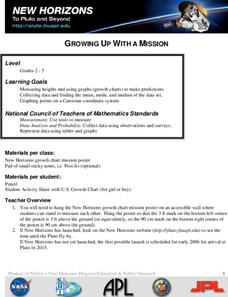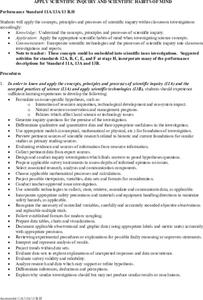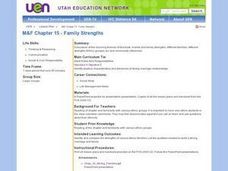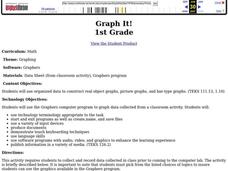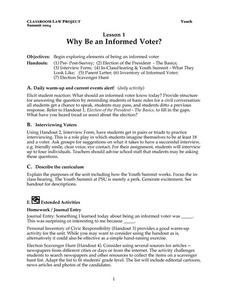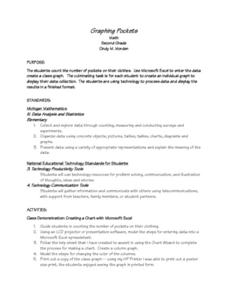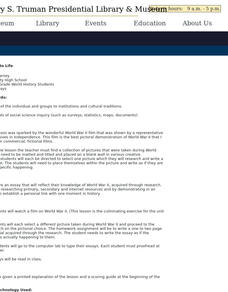Curated OER
The Secret School( Chapters 2 & 3)
Fourth graders read with a partner to practice reading. For this reading lesson, 4th graders will analyze the characters in the chapters of the book the Secret School. Students work on a list of important characters, complete a worksheet...
Curated OER
Do You See What I See?
Students hypothesize the role of rocks, soil, and water by observing a terrarium and create a model to explore the water cycle. This is part of a five station set up.
Curated OER
Up, Up, and Away
Learners create a model to explore the water cycle. Students also perform different experiments to witness water changing from a liquid to a gas. Learners are asked to if they can find ways for water to go away without pouring the...
Curated OER
Store Wars: When Wal-Mart Comes to Town
Learners research the impact of Big-Box Stores on local merchants and government. They view the program, "STORE WARS," and discuss the role big-box stores play in their lives. They complete an information form.
Curated OER
Mud Fossils
Students create their own fossils in an activity using plaster of paris and a variety of objects which can be fossils, e.g. chicken bones, twigs, shells, etc. After making their fossils, they allow them to dry and discuss time and its...
Curated OER
Mapping My Community
Ninth graders are introduced to GPS technology. They complete fieldwork as they visit a specific area of their community to identify and map types of land use in the surveyed area. They use the collected data to create a digital map.
Curated OER
Trash Count
Students identify pollution around their local community. They discuss the sources of polution and categorize objects based on their properties. They discover ways to make changes to the environment and how to inform the public.
Curated OER
Growing Up With A Mission
Student measure heights and graph them using growth charts for which they find the mean, mode, and median of the data set. They graph points on a Cartesian coordinate system.
Curated OER
Apply Scientific Inquiry and Scientific Habits of Mind
Learners review the components of the scientific inquiry method. In groups, they develop hypothesis on the issue given to them by their teacher and inquiry questions. They state the data in terms of qualitative and quantitative data. ...
Curated OER
Recycling
Students answer questions on a survey regarding their participation in ecology. They then discuss their ratings, what they never do, and think up two more additions for the list.
Curated OER
Social Studies: Family Ties
Students discuss the qualities needed for a strong family and marriage and identify and compare the strengths of various ethnic families. After viewing a Powerpoint presentation on family and marriage strengths and needs, they take a...
Curated OER
Tomatoes for Toyotas
Students investigate and become aware of our country's trade relations with East Asia with emphasis placed on Japan. They explore the global affect of technology, production, distribution and consumption as well as exchange and economic...
Curated OER
Inhalants: A Looming Threat for All Teens
Students identify common substances with chemical vapors. In this health science lesson, students explain the dangerous effects of inhalants. They brainstorm ways to warn other teens about the risks of abusing this substance.
Curated OER
Fair Trade: Chocolate Can Be Good For You
Students discover the process of chocolate production. They read stories from boys in Ghana and Brazil who work on cocoa plantations. They illustrate the principles of fair trade.
Curated OER
Graph It!
First graders use organized data to construct real object graphs, picture graphs, and bar-type graphs.
Curated OER
Exploring For Copper Deposits
Students examine ore deposits and identify factors in their origin. They analyze geologic maps, and locate porphyry copper deposits on a sediment geochemistry map.
Curated OER
In Your Own Backyard
Students observe organisms in their habitat and record their observations. They then draw conclusions about the organism's habitat needs and food sources.
Curated OER
Why Be An Informed Voter?
Students analyze what it means to be an informed voter. They interview others in pairs and triads and role play the role of a voter. They create a list of what it takes to have a successful interview and interview four individuals.
Curated OER
Graphing Pockets
Second graders explore graphing. They count the number of pockets on their clothes and use Microsoft Excel to enter their data. Students create a class graph displaying their findings.
Curated OER
Hazelwood v. Kuhlmeier
Students read the case text of the Hazelwood v. Kuhlmeier case. Using the text, they discuss the case history and the implications of the verdict. They share their findings with the class in the form of a PowerPoint presentation and...
Curated OER
Go Yankees!
Students use the internet to research the New York Yankees baseball team. After gathering their information, they discuss the challenges faced by the team and how they were overcome. They end the lesson by examining the math and...
Curated OER
Legends Coming to Life
Pupils prepare an essay that reflect their knowledge of World War II, acquired through research.
Curated OER
Mapping the changes in Canada's population
Students find and analyze data found in the census. They compare the population from 1996 to 2001. They explore the type of data they can find in the Census of Population.
Curated OER
Distribution of children living at home
High schoolers examine census data to evaluate the number of students of certain ages living at home. This data is then used to determine the need for day care, or other social programs. They use this information to explore social policies.




